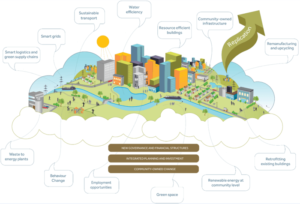
Real-time financial reporting is revolutionizing the way businesses operate, providing instant access to crucial financial data that drives strategic decisions. In today’s fast-paced environment, having up-to-the-minute insights allows companies to pivot quickly, seize opportunities, and mitigate risks before they escalate.
This innovative approach is not just about tracking numbers; it empowers organizations to monitor their financial health with key metrics in real-time, enhancing agility and responsiveness. By integrating advanced technologies and analytics, businesses can transform their financial reporting processes, leading to informed decision-making and improved overall performance.
Importance of Real-Time Financial Reporting
In an increasingly dynamic business environment, real-time financial reporting is becoming an essential element for organizations aiming to maintain a competitive edge. This approach allows businesses to access financial data as it happens, enabling more informed decision-making and timely responses to market changes. The significance of real-time financial reporting lies in its ability to provide up-to-the-minute insights into a company’s financial health, facilitating better resource allocation and strategic planning.
Organizations that adopt these systems benefit from increased operational efficiency, enhanced transparency, and the capacity to respond quickly to financial fluctuations.
Advantages of Implementing Real-Time Financial Reporting Systems
The implementation of real-time financial reporting systems offers several key advantages that can significantly impact business operations. These benefits include:
- Increased Agility: Organizations can make faster decisions based on current data rather than relying on outdated reports, enabling them to adapt to changes in the market swiftly.
- Enhanced Accuracy: Real-time data minimizes the chances of errors often associated with manual reporting processes, leading to more reliable financial information.
- Improved Cash Flow Management: Access to immediate financial metrics allows companies to manage their cash flow proactively, addressing issues before they escalate.
- Better Budgeting and Forecasting: Real-time insights can inform more accurate budgets and forecasts, as they reflect the latest financial trends and company performance.
Key Metrics Tracked in Real-Time for Financial Health
Monitoring specific financial metrics in real-time is crucial for assessing the overall health of an organization. Key metrics include:
- Revenue Growth: Tracking revenue growth in real-time enables businesses to identify trends and adjust strategies to maximize income.
- Operating Expenses: Real-time visibility into operating expenses allows organizations to keep costs in check and optimize spending.
- Profit Margins: Regular monitoring of profit margins helps ensure that the business remains profitable and can highlight areas requiring improvement.
- Accounts Receivable Turnover: This metric reflects how efficiently a company collects on its credit sales, providing insights into cash flow management.
Implementing real-time financial reporting not only equips organizations with the necessary tools to thrive in a competitive landscape but also ensures that they remain financially healthy and agile enough to respond to challenges as they arise.
Technologies Enabling Real-Time Financial Reporting

The landscape of financial reporting has transformed dramatically with advancements in technology. Organizations now rely on a suite of tools and software designed to provide immediate insights into their financial status. These technologies not only streamline the reporting process but also enhance decision-making capabilities, ensuring businesses can react promptly to changing economic conditions.Real-time financial reporting is facilitated by a variety of tools that integrate seamlessly with existing systems, allowing for an efficient flow of information.
This integration is crucial for organizations seeking to leverage their current accounting systems while enhancing their reporting capabilities. The following tools and software are integral to enabling this process:
Tools and Software for Real-Time Financial Reporting
A diverse range of technologies are available to support real-time financial reporting. Each of these tools brings unique features that cater to various business needs. Below are some popular solutions that stand out in the market:
- Cloud-Based Accounting Software: Solutions like QuickBooks Online and Xero provide instant access to financial data from any location. They enable automatic updates and real-time data synchronization across devices, making collaboration simpler.
- Enterprise Resource Planning (ERP) Systems: Systems such as SAP and Oracle offer comprehensive financial reporting capabilities integrated with other business functions, allowing for a unified view of operations.
- Business Intelligence (BI) Tools: Tools like Tableau and Power BI allow businesses to analyze financial data visually, enabling quick interpretation and informed decision-making based on real-time insights.
- Financial Dashboards: Customizable dashboards provide key performance indicators (KPIs) and metrics at a glance, making it easy to track financial health in real-time.
Integrating real-time reporting tools with existing accounting systems is essential for maximizing their effectiveness. Ensuring that these tools communicate with legacy systems can be a challenge; however, many modern solutions offer APIs and integration features that simplify this process. Businesses should consider the following aspects when integrating new tools:
Integration with Existing Accounting Systems
Effective integration involves several key steps to ensure smooth functionality. A few important considerations include:
- Data Compatibility: Ensuring that data formats align between the existing systems and new tools is critical to avoid discrepancies.
- API Functionality: Leveraging Application Programming Interfaces (APIs) allows for two-way communication between systems, enabling real-time data updates.
- User Training: Providing adequate training for staff on new tools enhances their ability to utilize the technology efficiently and effectively.
- Regular Maintenance: Keeping systems updated and conducting routine checks can prevent integration issues and ensure data accuracy.
When choosing solutions for real-time financial reporting, businesses often weigh the benefits of cloud-based solutions against traditional software. The decision hinges on various factors, including scalability, cost, and user flexibility.
Comparison of Cloud-Based Solutions and Traditional Software
Cloud-based solutions have gained popularity due to their ease of use and accessibility. Below are some distinguishing factors that differentiate cloud-based platforms from traditional software:
- Accessibility: Cloud solutions allow access from any internet-enabled device, promoting remote work and flexibility. Traditional software often requires local installation and can limit access.
- Cost-Effectiveness: Typically, cloud solutions operate on a subscription basis, eliminating the need for significant upfront investments that come with traditional software purchases.
- Automatic Updates: Cloud-based systems generally receive updates automatically, ensuring users benefit from the latest features and security patches without manual intervention.
- Scalability: Cloud solutions can easily accommodate growing businesses, allowing them to scale up or down based on their needs without extensive downtimes associated with traditional installations.
The choice between cloud-based and traditional software ultimately depends on an organization’s specific requirements, resources, and growth projections. The ongoing evolution of these technologies continues to enhance the capabilities of financial reporting, providing businesses with the tools necessary to thrive in a dynamic economic environment.
Impact on Business Strategy and Management

Real-time financial reporting has become a cornerstone of modern business strategy, allowing companies to make informed decisions swiftly and effectively. By providing up-to-the-minute insights, businesses can adapt to changing market conditions, optimize operations, and drive strategic initiatives with greater precision. This shift towards real-time data analytics is not just a trend; it has fundamentally transformed how organizations approach their financial management and strategic planning.Real-time financial insights empower leaders to make data-driven decisions that align with the organization’s goals.
With immediate access to financial performance metrics, businesses can identify trends, forecast future revenues, and manage cash flows more effectively. This agility in decision-making is crucial in today’s fast-paced market environment, where delays can lead to missed opportunities or increased risks. Furthermore, real-time reporting enhances accountability across departments, ensuring that all teams are aligned with financial objectives and contributing to the overall strategy.
Influence on Strategic Decision-Making
The integration of real-time financial reporting significantly influences strategic decision-making across various levels of an organization. Companies that leverage this information can respond quickly to market changes and optimize their strategic approaches.
Enhanced Forecasting Accuracy
Real-time data allows businesses to improve their forecasting models, leading to more accurate predictions of sales and expenses. This accuracy is essential for effective budget planning and resource allocation.
Risk Management
Immediate financial insights help organizations identify potential risks promptly. By monitoring key performance indicators (KPIs) in real time, businesses can mitigate risks before they escalate into significant issues.
Operational Efficiency
Organizations can streamline processes, reduce waste, and optimize supply chain management by analyzing real-time financial data. This operational efficiency directly contributes to improved profit margins and overall financial health.
Agility in Strategy Adjustment
Companies that operate on real-time insights can swiftly adjust their strategies in response to unexpected market developments or consumer behaviors, thereby staying ahead of competitors.
Case Study: ABC Corporation
ABC Corporation is a prime example of a company that has successfully leveraged real-time financial reporting to enhance its business strategy. By implementing a robust financial analytics platform, ABC Corporation gained access to real-time data on sales, expenses, and cash flow. This capability allowed the management team to make informed decisions that significantly impacted their operational efficiency and profitability.
Real-Time Performance Tracking
ABC Corporation utilized dashboards to visualize real-time financial metrics, enabling stakeholders to assess the company’s performance against targets continuously. This transparency fostered greater accountability among teams.
Dynamic Budgeting
The finance team at ABC Corporation employed rolling forecasts, adjusting their budgets based on real-time data, rather than relying on static annual budgets. This shift improved their adaptability and responsiveness to market fluctuations.
Enhanced Decision-Making
With immediate access to financial insights, the management could quickly identify underperforming products and adjust marketing strategies accordingly. This proactive approach led to a 15% increase in overall sales within one fiscal year.
Strategic Investments
Real-time insights equipped ABC Corporation to make better investment decisions, allowing them to allocate resources efficiently towards high-growth areas, ultimately driving their market share upward.This case study exemplifies how adopting real-time financial reporting can transform business strategies and lead to significant competitive advantages in the marketplace.
Last Word
In summary, the shift towards real-time financial reporting is more than a trend; it’s a fundamental change in how businesses view and manage their finances. By leveraging cutting-edge tools and systems, organizations can enhance their strategic initiatives, respond effectively to market changes, and ultimately achieve greater success. Embracing this approach is not just beneficial, but essential for thriving in today’s competitive landscape.
FAQ Explained
What is real-time financial reporting?
Real-time financial reporting refers to the ability to access and analyze financial data instantly as it becomes available, allowing for timely decision-making.
How does real-time financial reporting benefit businesses?
It enhances decision-making, improves cash flow management, and allows for better risk assessment by providing immediate insights into financial performance.
What tools are commonly used for real-time financial reporting?
Common tools include cloud-based accounting software, dashboards, and analytics platforms that integrate with existing financial systems.
Can small businesses implement real-time financial reporting?
Yes, small businesses can implement these systems using affordable software solutions that cater to their specific needs and scalability.
What challenges might businesses face with real-time financial reporting?
Challenges include data integration issues, the need for employee training, and ensuring data accuracy and security.






